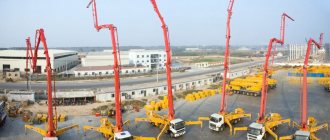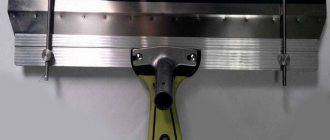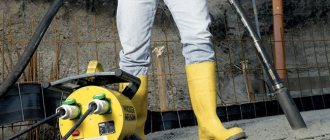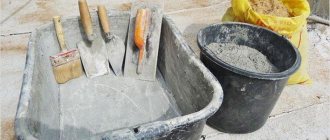Concrete is one of the most popular materials in the construction industry. In this case, concrete pumps play one of the most important roles in supplying this material to the place of installation. This can be a rotary or gerotor concrete pump for supplying concrete, stationary or mobile.
Concrete has a strong structure, which is why it is very popular in construction.
Concrete pump operation
Concrete pumps are special devices designed to deliver a concrete mixture directly to the work site during the construction of structures made of reinforced concrete or monolith. For this purpose, pipelines or concrete pipes are used. The operation of a concrete pump is based, as a rule, on the principle of displacement, that is, during operation, a volume is created in the system, which changes from time to time.
According to the principle of operation, concrete pumps are divided into:
Concrete pump drive diagram.
- piston (constant flow);
- hose with continuous supply.
In addition, based on the operating principle, they can also be divided into standard, trailed, mobile or truck-mounted concrete pumps for delivering concrete. They can be equipped with either a mechanical or hydraulic drive. The main parameters of concrete pumps are delivery height, distance and performance.
All pumps for pumping concrete differ in their operating principle. This is due to the fact that their devices are different. The advantages of this type of pump are the ease of operation of the hydraulic drive, low energy consumption and the cross-section of the hose, which has a constant size, which allows for the most efficient pumping. In addition, this also includes the ability to supply mixtures with lightweight aggregates, ease of use and operation in the future.
Of course, in addition to the advantages, such devices also have some disadvantages, the main of which are increased requirements regarding the mobility of the mixture, its composition and the solution supply distance.
Diagram of a single-acting piston concrete pump.
It is imperative to take into account the diameter of the concrete pumping pipes, since the larger it is, the higher its cost, therefore, the pressure of the supplied solution is lower. Today, concrete pipes have become especially popular, as they allow the solution to be delivered directly to the required location, eliminating the need to lay a pipeline.
Truck-mounted concrete pumps for supplying concrete in this case are more popular due to their small size. They can be easily moved to the place required for work.
Unloading dry material from a cement truck into cement silos pneumatically
Pneumatic unloading can only be performed by cement trucks that are equipped with special equipment
. The pneumatic unloading kit includes the following devices:
- Rotary compressor.
- Collector.
- Air duct system with valves and check valves.
- Pressure gauge.
- Moisture and oil separator.
Pneumatic unloading of a cement tanker is carried out as follows:
During unloading, the tank of the cement tanker is filled with air. A pressure of about 2 atmospheres is created inside. Air pressure causes the taps to open. Openings open through which dry dispersed material is unloaded. Air currents under pressure simply blow the cement out. Unloading dry cement pneumatically is much faster and easier than using the gravity method.
Features of a concrete pump
To start the pump into operation, you need cement laitance (or a chemical mixture). As for the first option, milk, as a rule, is made right at the place of work, for which water is mixed with cement.
Depending on the design of the concrete pump, the operating principle also changes. From the mixer, the mixture enters a concrete pumping hopper, after which it is pumped through a concrete pipeline to the required location. The concrete boom can be of various lengths, from a meter to several tens of meters. Filling can also be carried out using another device for delivering the mixture to the required location. This is a main type pipeline. It consists of metal pipes and is assembled at the construction site.
Scheme of operation of a hydraulic concrete pump.
The convenience is that you can always increase the length of the pipe to the desired length. The pipeline ends with a special sleeve made of rubber, also called a trunk. With its help, you can change the direction of supply of the solution during concreting. Using the main pipeline, as a rule, the foundation is poured into basements, since the use of a boom cannot be used in this case due to the presence of power lines there.
What types of concrete pumps are there?
The type of pumps can be different: hydraulic, mechanical. In addition, the design of concrete pumps for supplying concrete may also differ. Thus, there are piston pumps and pistonless, stationary and mobile.
As for the piston type, the principle of its operation is that the solution is sucked from the hopper, and in the opposite direction the mixture is pushed into the concrete pipe. The main advantage is the hydraulics of these devices. In them, the flow rate of the concrete mixture is almost constant, since the operation of the concrete pump, or rather the piston, occurs smoothly with a large stroke.
Diagram of a mechanically driven concrete pump.
Thus, the movement of the mixture through the concrete pipeline occurs evenly without various jumps. This makes it possible to reduce the resistance to movement of the solution, therefore, the engine power can be less than in a connecting rod concrete pump and a mechanical one. A concrete pump operating on hydraulics allows you to move the concrete mixture over a fairly large distance and height. Compared to a mechanical drive, hydraulics create quite a lot of pressure in the concrete pipeline.
A piston concrete pump tends to fail more often because the pistons wear out sooner. This happens due to friction, which is constant. Friction occurs due to the presence of microparticles and milk in the mixture, penetrating into the gap between the piston and the cylinder. Compared to hydraulic concrete pumps, mechanical devices fail faster, since the number of cycles of the pistons is much greater.
In a two-cylinder piston-type concrete pump, concrete can be supplied continuously, which makes it possible to alternately pump the solution into the cylinders. As for a device with a single cylinder, its operation occurs intermittently as the solution pulsates from maximum to minimum pressure (similar to piston movement).
Diagram of a trailed concrete pump: 1 – chassis, 2 – cylinder block, 3 – receiving hopper, 4 – concrete pump drive, 5 – casing.
In piston-type hydraulic concrete pumps, the special filler is water or mineral oil, which has sufficiently strong pressure, ensuring rapid loading of the concrete solution.
The rotary pump for concrete does not contain pistons. Its device consists of a housing with a rotor located inside, on which there are rubber-coated push and pressure rollers. The rotor also has a special rubber-coated hole in which there is a reinforced rubber hose.
This type of concrete pump is used, as a rule, in cases where the volume of work is not too large. In places where there is frequent reinforcement, this type complicates the laying of concrete. The main, but only, disadvantage of this unit is the short service life of the hose, regardless of the performance of the device itself. Damage occurs with crushed stone, which in this case is a filler for the concrete mixture.
Recommendations, tips
Using complex equipment is a responsible matter; you should listen to recommendations, advice, and read instructions in order to use the equipment correctly and get the desired result.
- Before starting the process, it is worth checking the device for the presence of hydraulic pressure. The pressure value is specified in the technical data sheet.
- Be sure to flush the system through which the solution is transferred with water. It is necessary to install a water pump to pump out the remaining water.
- It is possible to select a suitable mixture by testing compositions of different consistencies.
- The route along which pipes are located for transportation is laid out so that the number of bends is minimal. The pipes are inclined, the right angle is the wrong location of the concrete pipes.
- Before transportation, the concrete pipeline must be wetted; for this, a lime mortar is passed through, which forms a lubricant on the walls.
- Long interruptions in the supply of concrete are prohibited. If production stagnation occurs, it is necessary to pump the solution through the pipes at low speed every ten minutes.
- The main reason that indicates improper operation of the equipment is blockage in the pump. It is formed during prolonged stagnation of the concrete mixture, hardening of concrete that was made with violations in technology.
- When a jam occurs, the equipment is turned off to avoid breakdowns. You need to immediately determine the location of the blockage and clear it.
- When using the structure in winter, the solution is heated to 25-30 degrees, and the concrete pump itself is heated with steam.
Return to contents
Stationary concrete pump
This type includes a conventional concrete pump, which, as a rule, is installed on a platform or truck for the purpose of further movement to the desired location. There can be many options for such devices.
Figure 1. Concrete pump operation diagram.
This design consists of a trailer and chassis, as a result of which concrete is supplied continuously. A stationary concrete pump can be moved by attaching it to another vehicle. The principle of operation of the pump is quite simple: it is continuous pumping of a solution in large quantities. As for the operating modes of the pump, there are only two of them: one with a fairly high pressure, although the productivity in this case is much lower, the second with a pressure of a lower value (here the productivity is much greater than in the previous case). This need is due to the fact that in the process of laying concrete pipes (that is, pipes) at the corners, a sufficiently high pressure in the cylinders is required. This allows the concrete underneath to be raised.
Types of equipment
Concreting structures under different conditions requires the use of different types of pumps. There is a huge selection of equipment suitable for transporting liquid solution. Three types of installations are most often used.
Return to contents
Stationary
Stationary piston mortar pump.
The concrete pumping piston machine is located on a support with wheels. Used in long-term construction, construction of high-rise buildings. The equipment is installed for a long period of time and started by a gasoline or diesel engine. Using stationary equipment it is possible to:
- apply the solution to a height of more than 4 meters;
- the speed of supplying the solution is 90 m³ per hour.
A stationary installation has its advantages:
- small sizes;
- Possibility of installation almost anywhere;
- rental cost is low.
Return to contents
Trailed
Mobile installation of low power. It is very convenient to transport and fits anywhere on the construction site.
Return to contents
Mobile
The equipment is secured to the support of a special truck. The advantages are undeniable:
- significant power allows the delivery of 150 m³ of solution per hour;
- mobility, maneuverability;
- excellent performance, possible reduction in construction time.
The inconvenience of a mobile structure is its price. Large construction companies can afford to buy such a machine. This option is not available to a private developer. The solution may be rent, which is calculated for 1 hour of labor or delivery of 1 m³ of solution.
Return to contents
How does a concrete pump work?
The operating schemes for each type of concrete pump are slightly different, but there is a traditional one (Fig. 1).
Installing a concrete pump on any platform will not help add mobility, since it can thus only be moved across one area. In this case, the best option would be a truck-mounted concrete pump for supplying concrete, which is installed on a chassis. There are several more of them than the standard type of car of this version. Thanks to the mobility of this design, as well as the constant supply of concrete mixture, the concrete pump becomes more advanced.
The main feature of this pump is the presence of a special boom that can be folded out. It consists of fixed knees. Control, more precisely, lifting and turning, allows you to put the structure in the desired position in which the concrete solution is poured. For concrete conveyors, there are booms of various lengths, which allows for maneuverability and ease of operation.
Areas of application of technology
The pumps are actively used:
- on construction sites;
- when organizing loading and unloading operations;
- in warehouses of construction and production materials;
- at concrete plants, etc.
Interesting fact!
Modern equipment is capable of transporting dry material over a distance of up to 400 m horizontally and 50 m vertically.
Advantages and main functions of mortar pumps
Currently, modern construction of buildings implies the mandatory use of innovative advanced equipment and progressive technological techniques. To ensure the correct characteristics of the screed when preparing the floor, it is better to use special equipment. Mortar pumps are a type of functional technical devices that perform the entire process, from the production of the solution to its delivery to the place of work. This pump makes it possible to quickly supply the prepared building composition to the required distance and height using a special solution duct system.
The main advantages of using construction pumps of various modifications:
- pumps significantly simplify the construction process;
- pumps help perform work, increasing its quality;
- pumps ensure minimal labor intensity of the process;
- pumps contribute to a significant acceleration of the pace of construction work;
- pumps increase the power of the production process, allowing a large volume of work to be carried out.











